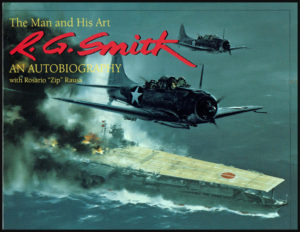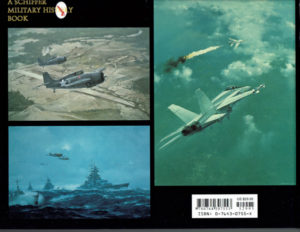« We had no television in those days, so my evenings were spent reading history or drawing, mostly airplanes”.
“[Lieutenant Commander Beaumont] influenced my life as an artist. […] He participated in Operation Deep Freeze in Antarctica. Where others saw only white and blue in this frigid area, Beaumont found wonderful color and conveyed same in his art. He added alcohol to his paints to prevent them from freezing as he worked in sub-zero temperatures for 30 minute intervals, retreating to a warmer area before going out again”.
“It was Beaumont who taught me composition, color balance, and how to look at a subject and translate the visual image to paper or canvas”.
“Beaumont emphasized it wasn’t necessary to reproduce an exact replica of a scene as long as the end result achieved dramatic impact”.
“Bob Poole taught me […] how to grey down vivid colors. He also taught me that by blending colors, I could add motion to aircrafts and add subtlety to harsh lines”.
“Understanding light and its effects is obviously critical to an artist […]. For instance, as the descending sun caught the side of a rusty tanker, it created a starkly bright copper tone. We learned that if we didn’t try to emulate that color on paper within 30 minutes, the light would be lost, and the rich copper tone would quickly change to a dingy, lifeless brown”.
“Aspiring artists want to know how to draw and paint, but very few want to take the time to learn”.
“Refrain from ever being satisfied with your work. Never stop rehearsing you craft. Every painting is another step in an endless learning curve. Achievement comes from hard work, discipline, and a constant program of practice and learning”.
“Accuracy requires study and thorough knowledge of your subject. […] Generally, more than 50 percent of the time invested in a painting went into research”.
“As to planning a picture, my approach usually entailed making several sketches of ideas for the scene I wanted to create before deciding on the final composition”.
“Create the background first, knowing beforehand where you intend to place the aircraft, which should be the last phase of your painting”.
“My criticism of much of aviation art today is that many artists feel they must paint every rivet on an aircraft, or every line on a ship. It often appears as though some artists cut their aircraft from a photograph and paste it on the background”.
“[…] the eye and the brain do most of the work, connecting the dots and lines. In other words, you don’t have to include every detail, just a suggestion of detail”.
“Study the works of artists you admire, or whose style you want to emulate”.
“Some artists only see an airplane as a mechanical object. As a result, their depiction of them is mechanical, stilted portraits of aircraft rather than a picture with character, motion, or some measure of dramatic quality”.
“I’m not a complicated man and it has never taken much in the way of material things to make me happy. Most of my pleasures have come from my family, my career, my hobby, my books, and my friends. The wonderful experiences and opportunities that came my way were frosting on the cake”.
Title: The Man and His Art. R.G. Smith / an Autobiography (with Rosario “Zip” Rausa)
Author: R.G. Smith with Rosario “Zip” Rausa
Copyright: 1999 by R.G. Smith
Edition: Schiffer Publishing Limited
ISBN: 0-7643-0755-X

